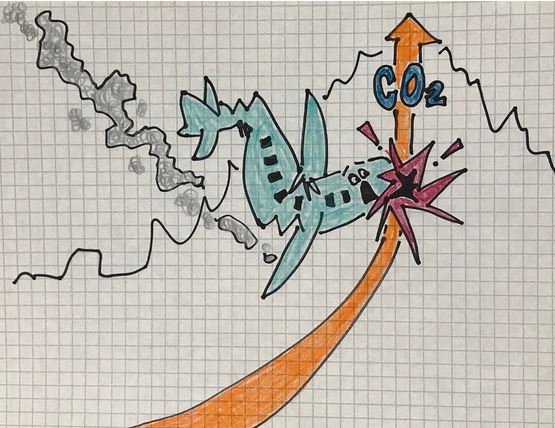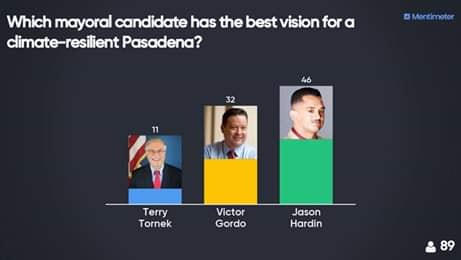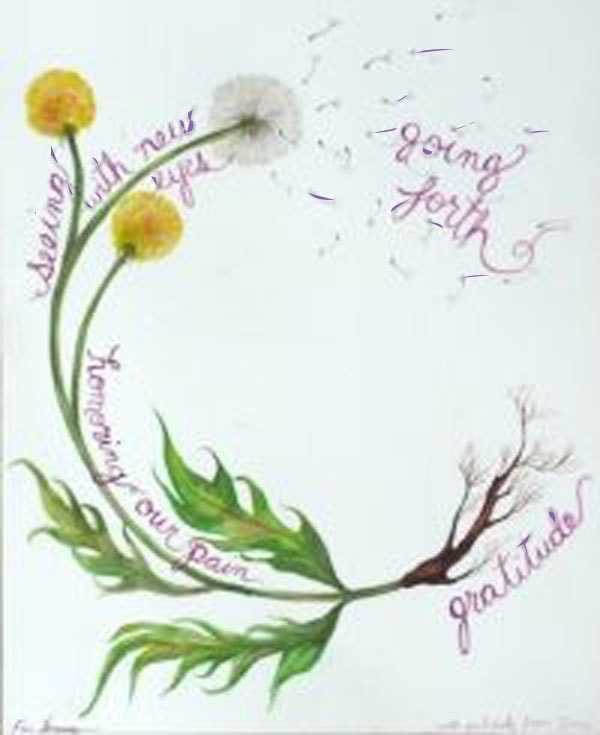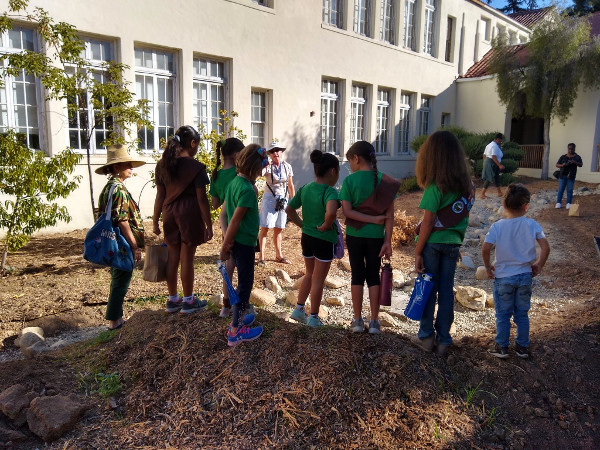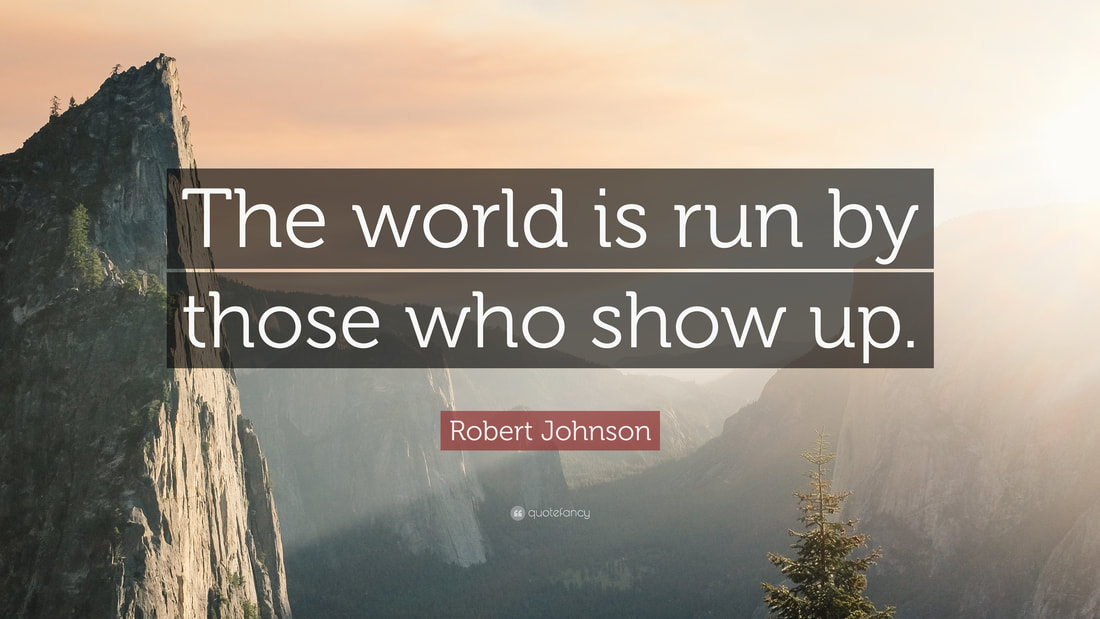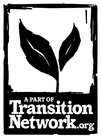|
Written by Greg Marquez
Edited by Jadene Mayla Rob Hopkins is a co-founder of Transition, a community organization dedicated to increasing cohesion between the forces of nature and those of humankind. In his latest book, Mr. Hopkins focuses on resolving our manufactured ills through one of our most valuable resources, our imagination. The book’s title is apt. Instead of confronting the hard and harmful complexities before us - the what is – he offers us the opportunity to consider alternatives – the what if – which embrace creativity, novelty, and a greater participation of human community in imagining the world. There is also value to the word imagination. It is simple, clear, and everyone understands and uses it; the author uses the word as a new way of speaking about problems. Concentrating and using imaginative power is not as simple a task as might appear, though, according to Hopkins. Over the years, and due to ever-increasing demands made for our time and attention, the capacity to imagine has decreased in the human population. Before they are placed in schools, very young children utilize their imaginations as a matter of course. It's an innate after all. Every instance of play, or of doing, is an opportunity to exercise that capacity. In one study, according to Hopkins’ investigations, three year olds and younger were given different numbers of toys to play with. The researchers observed that many toys reduced the possibilities and styles of play among the youngsters, while a lesser number of toys increased innovation and creative play. Too many choices produced confusion among the tots. In fact, in another study, little ones were invited into a room with no toys, and soon enough playing with sofa cushions became the order of the day for their amusement. Imagination, inbred as it may be and disposed by its very nature to expand thinking, is reduced in its influence by the media-rich, ever-more programmed world. The child is enrolled in school. Classrooms burdened with too many students do't allow for free individual expression. Antiquated teaching methods and even lesson content, which many of our grandparents were taught, do very little to extend or nourish individual imagination. Many would say it causes further atrophe. Even in “creative” activities we see this, where adding to one’s list of accomplishments towards a job resume becomes the purpose. To contrast this disparity in education, the author mentions a popular concept in Japan called ikigai. It is an ideal in living a life wherein loving, and doing, personal capabilities, and making a living combine to create the right balance for each individual. Such a state might be cultivated in innovative educational systems in countries like the United States. An institute of learning built around this ideology might not be called a school, for it would lay aside the programmed standard curriculum of our current education system. Each student could retain the right to author his or her own education based on interest and aptitude. Such a school was set up by concerned parents in Reggio Emilia, Italy, after World War II. This school is still operating and has a 'maker center' where students utilize creative facilities and guidance to make whatever they need to realize their ideas. Projects aided by qualified guides are the core of studies, and outdoor open spaces are readily available throughout the city’s three dozen schools and toddler centers. This Reggio Emilia model is understandably popular among visitors from abroad interested in innovative education. Hopkins also notes that for all ages taking the time to reflect, slow the thinking process, and allow for play and straying off task enhances health benefits, especially among those who suffer under stressful conditions. In another example from the book, a Dundee, Scotland, psychiatric therapy system has been in development since 1997. Initiated by a theatre company wishing to help those with mental disorders, the founders incorporated arts into their program. Those who had been treated at Liff, the city’s psychiatric hospital, exhibited their works of art at a city gallery. Fifteen thousand people attended, and a few years later, the enterprise received funding from the National Health Service. In the process of researching his book, Hopkins visited the site and was invited to attend a day’s activities. Unlike typical psychiatric wards where individual time, space and care are at a premium, once among the attendees he saw how each was treated with warmth and personal care to create something tangible and meaningful. He and his peers were not called patients or clients, they were artists. Those guiding them had personal experience with mental illness and so could bring their insight and compassion to their teaching. When he asked the director how exactly art helped people, her response was (abbreviated): Art is a form of communication, a social activity, a challenge (which stimulates creativity). It is educational, therapeutic, collaborative (ideas bounce around), can be shared with the community, and meaningful in reducing isolation and improving life. Moreover, anyone can do it. At a time when creative solutions are needed, perhaps more than ever before in the world, a tendency toward conformity as the means for settling issues could be replaced with creative use of our imaginations. Tapping into our creative powers takes focus in a landscape of distractions. Not only do many of us have the demands posed by our children, work, and societal issues, but we are also bombarded by a seemingly endless barrage of information overwhelming our senses. Value-based labels given to most accomplishments, foisted upon us by society, industry, and an economic system, are given, proclaimed, and pronounced to us and for us. Where is our valuation of the things we do? We must become not only aware of using and pairing our inherent gifts of imagination and creativity, but also of how to most effectively employ that capacity. In South London, members at Transition Town Tooting looked at their area of the city and noticed what they had been unaware of when buses moved along an unremarkable circular street. They asked what if… what if we had a village green right here where the buses make their turns? One question led to another, and before long, some funds were found, ukuleles (plus assorted instruments for others to join) were procured, large pots of flowers appeared, rolls of grass were laid out on the asphalt, and an agreement was arranged with the bus company to make their turns further down the busy High Street for the day. On the day of the “village green” many children came to play on the grass and people from the city joined Transitioners in comradery and celebration of what Transition organizers had done. Such a transformation is not impossible when viewed through imaginative eyes. It was accomplished because a group of interested people decided what they wanted and didn't simply accept what someone else had been able to envision. They asked what if questions that stimulated others to ask their own. For a fuller account of the event, go to the author’s website: www.robhopkins.net/2017/07/17 Many other examples point to applying what if questions to situations that seem unresolvable. Questions such as what if we made London a National Park? From this comes questions such as What if we could swim in all London’s canals? What if birdsong drowned out traffic noise? What if we rewilded all of London’s golf courses? What if every street had public art? What if we could grow what we need to eat right here where we live? Such questioning can be applied anywhere, and should be. We can practice honing our imaginative skills with what if questions of our own. For example, here in Pasadena, what if we had a Maker Center where people could come in and make or repair things anytime? What if we had a group of Transition folks who connected requests from crafts people and the folks needing their skills? And what if payment could be cash, commodity or skill trade, or nothing at all? Such questions generate solutions that are totally dependent on the people involved, rather than requiring outside resources or support. After reading this book, I would like to encourage you to think of your own, and let’s put out what ifs together. Written by the Web Master for Transition Pasadena
Last week, I interviewed Chery Auger of BanSUP.net to help her expose a real conspiracy involving plastic. Her work focuses on alerting the public to the hidden truths behind the plastic crisis, and I wanted to help spread her message. In the show I did with her, available at https://youtu.be/dsBDNeLyOUg, we share both the facts and the big secret that plastics manufacturers don't want the public to learn. It reall is shocking. Some highlights: did you know that plastics manufacturers are pushing an agenda and that it causes cancer and other serious diseases? Watch the interview to learn the rest! Plastics manufacturers are hiding something every person on the planet deserves to know, and Cheryl and I show you how to take effective action to halt their dangerous anti-environment, anti-health agenda. If you want to do something right now, here are three things: State Legislation currently in process needs your support. Here's what you can do right now: Meet with or send (regular mail is counted the most!) letters to your State Senators and Assemblymembers about why they should support the following bills: Federal Legislation is also currently in process and needs your voice. Here's how to make an impact:
Together, with knowledge and effective action, we can help stop plastics manufacturers from desecrating our sacred planet and endangering our health. Remember to watch the interview here to learn the full story of plastic, and help Cheryl spread the word by sharing it with your networks: https://youtu.be/dsBDNeLyOUg #plasticsmanufacturers Written by Sylvia Holmes
Image credit Therese Brummel Edited by Jadene Mayla Just like all of my other projects, my interest in the carbon footprint of flying was strong enough for me to seek out scientist and author Peter Kalmus. In our April 13, 2018 Skype call, he explained that when he calculated his carbon footprint, he was surprised to discover that the biggest culprit was flying. So he made the commitment to not fly. (See his book Being The Change.) When he asked other scientists how they can square flying with what they know about climate change, they said “I just don’t think about it”. When I interviewed Peter over Skype I discovered that it can be hard for a scientist to give up flying. Think of all of the conferences held in other countries, all those chances to network and boost their career. Peter wanted to see if there were other scientists who had committed to not flying, so he started No Fly Climate Sci https://noflyclimatesci.org/ in 2017. It made him “feel less crazy” and helped him find his community. But he wants more. He wants to change the current culture so that more scientists, and non-scientists too, will choose to not fly. What if it became uncool to fly? Flygskam, or “flight-shame”, is cited as the cause of reduced flights in Sweden. But in the US, the current culture ignores the disconnect. Why is it that we can fly and not think about the damage that flying is doing to the planet through a huge per capita dose of carbon emissions? How can we change the culture, right away? Climate scientists are more familiar with the data and are prime candidates to start this cultural shift, hence the name of Peter’s website. But next, Peter thinks, academics in general should jump on board. That would also help because academic institutions are involved with most of the conferences that scientists fly to. Academic institutions could offer alternatives to flying in the form of online and local conferences for scientists. And if scientists could model this localization and digitization of climate crisis mitigation behavior, it might help the rest of us rethink our assumptions about airplane travel. So far 17 academic institutions have signed on at NoFlyClimateSci.org. The University of Maryland signed on and said that their ultimate goal is “to eliminate the university’s air travel carbon footprint”. We are not all scientists or even academics. So what about the rest of us? We fly to visit our families, we fly for work, and we fly for fun. Maja Rosén was flying as a tourist from Sweden to Norway when she suddenly realized that the flight she was on was melting the glaciers in the very fjords she had come to see. So she started her own initiative, a website asking people to pledge not to fly. She realized that it would be easier for folks to make that pledge if it were short-term, for just one year, and only if 100,000 other people also pledged. You can do anything for just one year, right? When 100,000 people do something, that’s a movement. You can be a part of hers by signing the pledge. The USA version is here: https://www.flightfreeusa.org and you can read some of the many stories by people who have signed the pledge here: https://www.flightfreeusa.org/our-stories Locally here in Pasadena, we need to start talking about flying, or rather not flying. Talking about not flying may be hard to do. We as a community can disagree due to our various lifestyles and work, etc. The decision can divide families, workplaces, and even travel companions. It may be hard to convince others or the public at large, but any of us can make a pledge about our own choice of transportation when it comes to traveling. Peter’s site is a great place to write about your own personal decision not to fly or to fly less. All are welcome to join. Next, we need to act. US Representative Curt McCormack of Vermont took the pledge to not fly in 2020. He said “something has got to give. We have to stop talking about climate and start acting. I will keep taking Amtrak.” The climate crisis is a genuine climate emergency, and one of the best reasons to stop flying is to communicate that emergency via actions. You can help spread this movement. Go to https://noflyclimatesci.org/ and tell your story of why you have decided to stop or reduce flying, and go to https://www.flightfreeusa.org and pledge to not fly in 2020. You can also write your local elected officials and ask them for their thoughts on this topic. You might be surprised by what they tell you when they write you back. I invite you to think about this issue and take action. Our local youth are amazingly well informed on Climate! Last week’s Candidates Climate Forum was a very professional, slickly-run event at the new Jackie Robinson Recreation Center. It left the impression that these are young people to pay attention to. A diverse crowd of 150 attended. Multiple cameras filmed the student-run forum, which included questions projected overhead, which was an especially ideal photo op for the section in which only yes or no cards could be displayed.
Mayor Tornek called this yes/no format unfair. Victor Gordo and Jason Hardin stood apart from Tornek’s “no” on the question of reinstating a Sustainability Officer in our city. Major Williams, the remaining Mayoral candidate was a not in attendance. After the one hour of questions for Mayoral Candidates there was a straw poll taken via menti.com. Surprisingly, Jason Hardin came out on top with 46 votes among the 89 who voted Via cellphones. Gordo, 32 votes, Mayor Tornek 11. The crowd cheered when Hardin talked about $1 Uber rides and free bus fare for students. Sunrise Sequoyah hosted this event with help from Pasadena Complete Streets Coalition. About 10 orgs also co-sponsored and had info tables set up to talk about Pasadena becoming more resilient to Climate Change and decreasing its carbon footprint. The youth promoted zero waste with Alta Pasa Green Circle dishes for the free vegan sandwiches and oranges they provided. City Council Candidates then took questions from Ozzy Simpson and Selina Yang of Sequoyah, a freshman girl from PHS, and one from John Muir High, a PCC student who is fostering 10 oaks he recently planted in Eaton Canyon, and David Azevedo of Complete Streets. D2 Candidate Felicia Williams stood out with 10 years of working with the city on environmental issues. She and LA housing expert Tricia Keane were close in their tallies of 26 and 33 respectively. Their opponent, Litwin took one vote. District 6 Steve Madison, the only Council incumbent to participate in round two did not impress the crowd earning only 8 votes. His opponents, Bell, 42 votes and Godley 4, were up to the challenge speaking to the Climate crisis. D4 incumbent Gene Masuda was absent. His competitors Bland, 43 votes and Wheeler, 9, gave a good showing. Tyron Hampton incumbent D1 is running unopposed. He did not participate, though I would have loved to hear his views on climate. And to see if the crowd would have voted yea or nay. Kudos to the thoughtful and passionate Sunrise students for masterfully organizing and manifesting this event!! https://pasadenaweekly.com/organizers-declare-success-with-first-youth-led-climate-action-forum/ Therese Brummel This groundbreaking workshop arose in direct response to the ecological, social, and economic crises of our time. Ecospiritual leader Joanna Macy created it to help people understand and meet these challenges with clear eyes and open heart, without letting emotional overwhelm induce psychic numbing, panic, or scapegoating. Cheryl Leutjen and David Cutter will be facilitating a local opportunity to participate in this healing workshop.
Several of us Transitioners drove to Oakland in 2013 to participate in a similar workshop led by Joanna Macy. She was 83 at the time and vibrant. I would describe her workshop as a chance to reconnect to spirit. Reconnecting to Gaia, to Mother Earth. Becoming a Gaian. We are all connected through spirit. It is only the industrial growth society and deeper issues that we grew up with that cement the illusion of separation. When people get this connection they can understand that Gaia speaks through all of us. With that shift in consciousness, transitioning to a new way of being on Earth is possible. Getting this concept was hard though. I got it from being in a heart space(feeling) rather than being in my head(thinking). This workshop is about creating opportunities for people to move into their heart space. Once there, it is much easier to grasp the connectedness of all beings. Cheryl Leutjen and David Cutter will be facilitating this workshop at Throop on April 11, 2020 from 8:30 to 4pm. This will be our third Joanna Macy workshop that Transition Pasadena has produced. If you missed the first two you owe it to yourself to experience this one. There is no cost to attend the workshop but when you register at eventbrite there will be a $20 option to pay for a catered vegan lunch. Alternatively, you can choose to bring your own lunch at no cost. While Joanna Macy won't be at this workshop in April, we will try to evoke her spirit by doing a series of experiential activites with a pinch of explanation, All serving to create that heart space and help people rediscover their innate connections to each other and the self healing powers of the web of life. We hope participants come away feeling enlivened and motivated to play their part in creating a sustainable civilization. Please register at Eventbrite by March 25th. Cheryl and I will also provide a sample experience at Throop after service on March 29th, 12pm. Throop's address is 300 S. Los Robles Ave. Pasadena 91101. We hope you can join us for this uplifting experience. When snowpack melts off the San Gabriel Mountains, and whenever it rains in Altadena and Pasadena, the water seeps down into the ground to refill the Raymond Basin, the giant underground aquifer that provides 40% of Pasadena’s water. The water that falls on impermeable street surfaces is swept to the ocean, lost to us forever; but the water that falls on soil remains in our ecosystem and eventually percolates down into our reservoir. It’s a gift that nourishes life, if we’re prepared to receive it.
Our walk started with a simple idea: we wanted to highlight the Pasadena Public Health Department and Pasadena Water and Power’s new hydration station at La Pintoresca Park, and connect that with the water-wise plantings at nearby Washington Elementary and Washington Park. Both locations showcase the use of bioswales to receive, collect, and filter water into Pasadena’s aquifer, and the use of California native plants to support the birds, insects, and butterflies that quietly enrich our ecosystem and sustain our human lives. Bioswales and native plants are an important part of the Complete Streets toolkit for greener, healthier, water-wise streets. As we organized this walk, I began to understand more deeply that Pasadena CSC is part of a similar ecosystem of people in Altadena and Pasadena who are working, step by step and drop by drop, to repair our ecosystem and society. They’re challenging the way we handle water, health, and transportation with hands-on, reliable, nature-based, and human-scale solutions. And they met us enthusiastically, with an openness and understanding that we’re all connected, and all in this together. We’re grateful to Sherreeta and Mary from Pasadena Public Health for sponsoring and partnering with us to build this walk, and to Jonathan from Pasadena Water and Power, who met us bright and early at the La Pintoresca Library to hand out water-related goodies. Wendy from Planning and Community Development taught us about the pocket park to the east of Marengo and Washington, where a community sculpture by an artist named Lt. Mustardseed welcomes neighbors to relax and rest. We’re grateful to Lois from the Pasadena Audubon Society and Tahereh from Beautiful Bioswales, who tag-teamed to lead us through a tour and explanation of bioswales at Washington Elementary’s future outdoor classroom. We’re proud that our CSC member Topher, who volunteers with Friends of Washington Park, was on hand to share his botanical knowledge about the butterfly garden he helped to plant at the park. We can’t leave out April from Water LA and Paloma from Arlington Garden. Although we weren’t able to feature their work in our walk, we deeply appreciated how they greeted us in a spirit of connection to our shared goals. Finally - and perhaps most of all - we are extremely proud of, and totally awed by the group of 15 Jackson Elementary School students from a local Girl Scout Troop who joined us for the walk as part of their work to get a “Water Wise Badge”. They worked and walked hard to receive their badges, and we are grateful to their parents, who accompanied them in love and support. They, along with our other adult participants, made everything worthwhile. When we shared that all of the groups featured on our walk offer volunteer opportunities, our walk participants nodded in recognition and appreciation. They, too, are a part of our ecosystem of future builders and leaders. We hope to leave a better world with reliable, clean water and safe, walkable streets to all of our children – and to ourselves as well. by Candace Seu, a member of Beautiful Bioswales (originally posted at Pasadena Complete Streets Coalition blog https://www.pasadenacsc.org/blog/2019-10-28-walktober-water/) Photo credit: photo by SPL 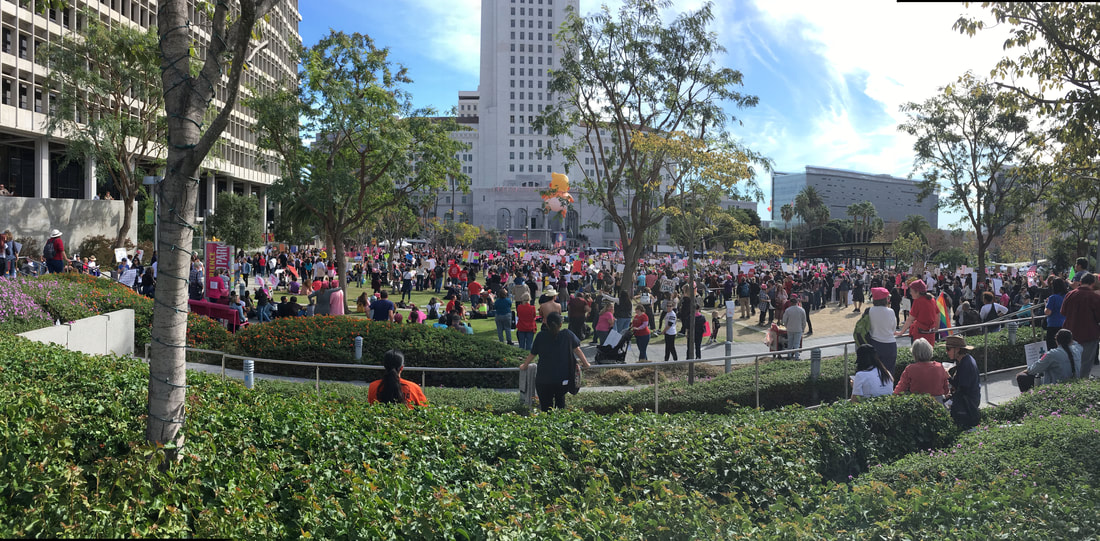 Somewhere in the center of the photo is the crowded platform for guests and speakers, Mayor Garcetti is describing the list of departments in his city that have as their heads very capable women. I lost track of which branches of the city were directed by women, but the Mayor went through quite a number of them. Entertainers, musicians, political dignitaries, pop singers, and a host of other names I didn’t know also expressed themselves. The orange ballon lofting in the middle represents the 45th. Orange hair hangs down his head. I didn’t see a sign, but I bet it could have said, “Full of hot air.” The Gold line train pulled into Fillmore Station just a couple minutes after I swiped my card at the stand and noted the few people sitting and meandering on the platform. Normal. Uncrowded for a Saturday morning save for five or six young ladies, each with handprinted signs that proclaimed the rights of women in different ways and toughness. I was to see many more such signs as the morning progressed.
Union Station was quite crowded. Lots of folks were heading down to the lower platform for the Red and Purple Lines, many more of whom were also carrying gender rights signs than not. The crowds detraining at Civic Center and Pershing Square Station were predominantly women. Many men were accompanying them, too. Others, were many singles like me and also twos and threes, like the women. I was wearing a bandana which I often wear these days to keep my increasingly broad bald forehead from dissipating heat. On Saturday, I was wearing red. It was a proclamation in itself, since over the years I have come to recognize my own feminine half as not only vital, but critical that it be recognized and strengthened. So, I am a feminist and as such felt I had to add my grit to the movement of honing the rights of women. Because of the bandana I suppose, some women acknowledged me with a smile and sometimes a greeting. A few were young and most were older, which is normal in my experience. That I am an elder weighs more it seems that gender. I must say it felt good to be recognized by those who greeted me. I felt belonged. That showing up there added up in the grand scheme of things. Up on the street, police worked in pairs – many, with both genders – no cars consumed the marching route, so I simply fell in with the direction others were taking along Hill Street, past Grand Central Market where the revamped Angels Flight Railway across the street will save you walking down and up for a couple tacos and a beer at a stand in the market. Many were walking the space between curbs as I walked for several blocks, but it was not as jam packed as I had imagined it would be. Then, as I approached the prominent edifice of city hall, I could hear a loud loudspeaker, and when turning a corner, there they were, thousands of people jammed in front of a makeshift speaker platform at the city hall’s front door where dignitaries were adding their energies to our own presence. Not long after the Mayor spoke some were wandering away, and I could wend my way through bodies of arms and legs and head over to high ground for a better view. The last shot is a panorama of the space under construction that is converting the area into a new city park. This was the fourth Women’s March; the first with the President’s first year of office, and the numbers grow larger with each year. This is also the 100th year anniversary of women’s right to vote and with that a focus on the power collective action is producing. Last week, I wrote a note in my diary about an old friend who I call in my thoughts, 21st Century Woman. She listens. Then, as necessary, responds. She laughs easily because she is easily amused. That is, the weight of an idea need never be taken to calamity. She is generous in obliging others, not for friendship but from kindness. I sense whenever I am speaking with her that I am for her, on her side when fairness and truth are required. It is out of wanting the joining of hands that I say I am a feminist. Alongside my maleness is the feminine; a wish to take your hand as you reach out for another’s. And now I am here. I know that coming together is the road to take. I want to reach out to my compatriot brothers to join in with us, and to other brothers who are learning to discover their own feminine parts to join too. But that is hard. Many of my brothers are stuck in time. Maturity for many is still at adolescence.The Gold line train pulled into Fillmore Station just a couple minutes after I swiped my card at the stand and noted the few people sitting and meandering on the platform. Normal. Uncrowded for a Saturday morning save for five or six young ladies, each with handprinted signs that proclaimed the rights of women in different ways and toughness. I was to see many more such signs as the morning progressed. I must be like my 21st Century Woman friend, kind. Understanding. Not take a thoughtless remark personally, but see it as a habit ingrained by paternal friends over the course of many many years, if not generations. I ask my sisters to join me, for theirs is the harder chore. As I listen to my brothers and sisters, I must respond, thoughtfully, take into consideration what I wish to accomplish. Bring everyone into the fold. No one can be excluded. Everyone counts. by Therese Brummell
It’s a huge existential question, but it was posed in our recent Transition steering meeting by Sylvia who was inspired to ask it in the context of our work. Four responses were elicited from each participant. Here’s how the responses grouped, according to my unscientific method: 7 were present for ACTION. 5 cited PROBLEM SOLVING. 4 responded for FUN. 3 came for COMMUNITY. 2 responses were for the NEXT GENERATION. Here are the 7 ACTION-related reasons people showed up to the steering meeting that night:
The 5 people here for PROBLEM-SOLVING wanted to work on:
FUN-related comments reflected an attitude that spending life’s energy should be FUN. Fun propagates energy and draws people in. Creating Fun with like-minded folks gives a sense of hope. COMMUNITY-building is the basis of the Transition Network. It is Transition’s stated antidote to climate change and in anticipation of tougher times ahead when we will, of necessity, live more locally and be more dependent on our local networks for many things. NEXT GENERATION Showing up because of the need to do something to leave the world a better place for the NEXT GENERATION is a mission known to our Native American predecessors who think about the Seventh Generation ahead. Indigenous peoples promote mindfulness in every action we take, framed by its outcome for future citizens of Planet Earth. What will our world look like 150 years from now, and how can I contribute today, to make this a more beautiful world? Moment by moment, choice by choice, action by action perhaps we can do this for future generations. Thich Nhat Hahn says Peace is Every Step; Peace in Every Breath. Ensuring Peace and the resilient vitality of this beautiful home we call Earth is in every choice we make. Getting to read what each steering member shared was an inspiring experience. It’s great to know we each come for reasons that are at the same time unique and aligned. Why are YOU here? by Greg Marquez
On the first evening of the Grass Valley Immersion event I attended this year, we placed our chairs around the fire circle. The sacredness of the place reflected the substance of the weekend to come. The fire tender’s expert movements belied his youthful appearance. I watched as he unwrapped a bundle, took out a flat stone, a small bow with string, a stick slightly charred on one end, and a flat piece of wood also singed from other fires. He looped the stick around the string, placed the rock in the palm of his left hand, and grasped one end of the bow with the other. Then, with one end of the stick against his palm and the other end pressed firmly on the flat wood lying on the ground, he moved the bow back and forth to test the turn of the stick as it spun first in one direction, then in the other. Satisfied that the spinning would serve its purpose, the man placed a handful of fine moss at the point of friction between woods, and pulled the bow back and forth again. Before long smoke came out of the clump of moss, and he picked it up and blew a few times on its embers. When the fire caught, he placed it carefully into the prepared nest of moss and shavings over which artfully spaced sticks brought ample air to feed the rising flames. Absent in my day to day existence, this fire building ritual gave me a hint of what spiritual experiences I would be part of at the event. Calixto, whom I had met at last year’s gathering at Grass Valley, was principal. Grandfather Woableza, a Lakota/Dakota elder from Pine Ridge, South Dakota, and an honored guest at the event. The substance of their messages was essentially to recognize the divine and spiritual in all things and actions. In so doing, they taught, the inner world where individuality lives is intimately connected with the outer world. We are not taught that connection in contemporary society. The common interpretation we share is that there is this internal me, and the rest of the cosmos outside of me is not me. The result of this thinking is our feeling separated. How this intimate connection is made between two worlds is the essential driving force of many wisdom teachings through time. While Grandfather brought tribal songs and sang them in his soft native tongue, Calixto brought narratives, taught to him through decades of discipline by his Arhuaco elders and by the many global cultures he has visited on his travels. These narratives were stories, ritual blessings, and prayers which effectively gathered us together toward the group’s wished-for wholeness. At one point during the evening, someone mentioned the power that fire has, and Calixto posed this question: Which is consumed, the fire or the wood? The question seemed odd to me, and yet upon reflection, I realized that fuel and fire consume each other; fire consumes the fuel until it is gone, then the fire goes out. Fuel has thus essentially consumed the fire. Is this an illogical play of ideas, or a perspective from a separated life? Is the question an invitation to consider how to think in a more connected way? Early the next morning, after lighting the fire again and praying to the four corners and to Earth and sky, Calixto asked many of us individually to lead the group in blessing people experiencing misfortune. Grandfather was asked to contribute, and he sang a Lakota/Dakota hymn. One person was asked to pray for blessing sick and starving children, and another for the millions of immigrants displaced around the world, and yet another for the peace and well-being of the globe. Others, perhaps not accustomed to praying, let alone for others we did not know, were asked to lead in our own blessings. As participants prayed, their voices and feeling seemed to shift the space between us all into a peaceful, enveloping tone. With each prayer, the sounds were woven into a general mood of personal absorption and respect, and I felt a cloak of calm and wholeness settle among us. Among the participants was also a Zapateco from Oaxaca who was invited to contribute remedies for healing. His medicine was the sound and sensations of musical devices including a large collection of wooden and clay mouth and nose flutes - most of which he had made himself. Among the instruments were drums and drum-like instruments, bells, whistles, and other sound-making devices, all which served to augment hymns and prayers, and were – on their own - medicine of blessings and gratitude. At breakfast, we gathered in a circle and one member was asked to give blessings for the food. The cook and his helpers then described the ample and flavorful assortment of vegetarian and non-vegetarian delectables laid out before us in the morning sun. This was done at each of the meals, and like the artisan of fire-making, the chef too was meticulous about his task. He described the simple but expertly prepared dishes; what spices were used and a brief run-down of the cooking procedures. As he spoke, his care with process was apparent. Onions, garlic, and diced peppers were sauteed in butter for added flavor before the rest of the dish was cooked. These steps revealed the caring he put into his food as well as his expertise as a chef. What we ate was grown locally, most on the very property where we were standing. Chickens and eggs were local too, as was the lamb served as a stew; these had been raised by friends and massaged for tenderness. Many hands and minds were involved with successfully and happily feeding the lot of us. This caring meeting of hands and minds contributed to the return to wholeness toward which the weekend of immersion was aiming. As I reflected upon this, I thought that wholeness is not static but movement, an instant of living within a continuously moving process that doesn’t stop or end, as far as I can tell, after death. To become whole for every human is perhaps to continually experience purpose, to participate with the flow of thought, feeling, and activity as it continuously occurs, and make out of that what one can. When internal and external become integrated, as is experienced on occasions such as at the Grass Valley Immersion event and even sometimes without the assistance of dedicated weekends, integration of the two worlds of inner and outer self can occur. These moments can take the form of chance meetings, books read, and “accidents.” The process of movement toward wholeness is itself the whole. Conscious engagement with intentional and chance movement toward wholeness I’m talking about moves a person into an increasingly more alert, aware, and capable state of mind that allows one to confront and manage whatever comes up next for the good of one’s self, for the benefit of people around us, and for all and everything in the cosmos. |
Transition Network NewsOther Resilience NewsOur Previous Posts
June 2024
|
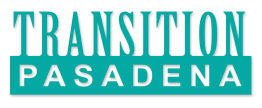
|
|
|
• Home
• Latest News / Event Photos • Throop Learning Garden / History / Garden Photos • Repair Café Pasadena / Photo Gallery • Get Involved / Contact Us  Content on this site is licensed under a Creative Commons Attribution-ShareAlike 4.0 International License. |
Site design: Qrys Cunningham
